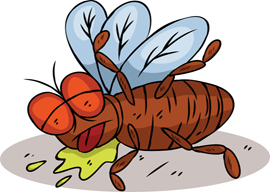
November 18, 2017

Source: Bigstock
I returned recently to my house in France for a brief break. The weather was of the best—a cloudless sunny sky, warm and dry. It was almost perfect, but there was a fly in the ointment, the fly in the ointment being the flies in our bedroom, hundreds of them. Why they should have gathered there I do not know; but as an ancient philosopher so wisely said, whatever happens must be possible.
There were also, as it happens, immense numbers of ladybirds on and around the windowsill. They are sluggish creatures at best, and while we wanted to dispose of the flies in any way possible (so long as it was fatal to them), we wanted to preserve the ladybirds. This was easy to do. We gathered them up and threw them out of the window.
Everyone (apart from an entomologist) abominates a fly, but everyone loves a ladybird. We think ladybirds are pretty and symbolize a peaceful existence, though in fact they are carnivorous, unlike flies, at least the flies in our house in France, which are certainly not carnivorous and far more peace-loving than ladybirds, even though they buzz. They might like carrion, but as contemporary moral philosophers will tell you, carrion has no rights and therefore no moral duties are owed it. It is different with aphids, which are the prey of ladybirds. Aphids are living creatures, and suffer as such. Ladybirds don’t give a damn about that. With a large garden all around them, they do not choose the vegetarian option. They are bad insects, from the moral, though not the aesthetic, point of view.
Although it is not strictly germane to my argument, let me just mention—in order to praise—the entomologists whom I have known, some of whom specialized in flies. They were to a man (and one woman) fine people: intelligent, upstanding, cultivated, amusing, and very interesting. Some superior persons, when they wish to disparage someone else’s intellectual activity, call it mere entomology, as if entomology were rather like trainspotting, a matter of near-mindless classification. But I have admired the intellect, and even more the character, of the entomologists whom I have met. They need the humility to study minute particulars with the closest attention, but no less than other scientists do they need imagination to frame their hypotheses. They see a deeper beauty where others see only the superficially repellent. In a way, they are religious.
But to return to the flies: We didn’t want them, whatever the fascination of their biology, or their admirable anatomical construction when seen through a powerful magnifying glass. My wife tried a broom to shoo them through the open window, but it was soon clear that they would not go in the desired direction (as if they were being deliberately awkward, like adolescents who do exactly the opposite of what you want them to do). Besides, it was also soon evident that the broom was more likely to destroy the bedroom than to rid us of the flies.
Fortunately, we had some fly papers. They were not like the fly papers of old, impregnated with arsenic, which middle-class Victorian housewives used to soak and then feed their husbands in a nice cup of tea (ease of divorce has made arsenic redundant, though it is now also quite difficult to obtain).
No, you pulled these fly papers out of a little cardboard tube and hung them up. They had a gluey substance all over them—one of the fly papers almost caught me, to say nothing of the flies—which is presumably impregnated with something that attracts flies, for it is too much to hope that they would land on the fly papers in large numbers purely by chance.
And in fact it didn’t take them long to start landing on them. One landed just as I was hanging a paper to the lamp fixture. Once on the paper, of course, they couldn’t get off, however hard they tried; indeed, their struggle glued them all the more firmly. Before long, the papers, a dark wood-chip color, were dotted with black flies, like raisins in a cake.